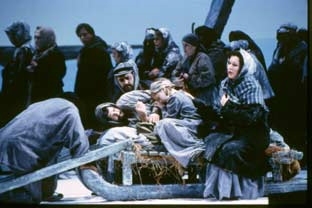A cellist, conductor, teacher and designer of musical instruments and toys, Tod Machover is perhaps best-known as a composer of innovative music that synthesizes acoustic and electronic sound. For his opera, "Resurrection," Machover, professor of music and media in the Media Lab, used his trademark "hyperinstrument" electronics, adding rhythmic punch, melodic embellishment, delicate texture and enhanced bass to the sonic palette.
From Nov. 7-20, the Boston Lyric Opera presents the Boston premiere of "Resurrection," with a libretto written by music and theater arts Lecturer Laura Harrington. Commissioned by the Houston Grand Opera, which premiered it in 1999, "Resurrection" is based on Leo Tolstoy's final novel, an unusual love story between a prince and a serving girl whose fates become intertwined when the prince sits on the jury that unjustly condemns the woman to prison.
The Houston production received international praise, with the Sunday Boulder Camera noting, "The music is tonal, bewitchingly beautiful and totally engaging" and Opera International writing that the work "seduces us, impresses us ... even excites us [with] ... music perfectly integrated with the action."
WGBH radio (89.7 FM) will present a live broadcast of "Resurrection" on Sunday, Nov. 18 at 3 p.m.
The following are excerpts from an interview with Machover by Mara Littman of the Boston Lyric Opera, published in the company's fall 2001 issue of Intermezzo Magazine.
Q: How did you start to combine music with high technology?
Machover: I grew up with technology and music around the house. The combination of the two worlds seemed natural to me. My mother was a pianist/music teacher and my dad was one of the first people who designed graphics systems for computers. He had this conviction that you had to have a human way to interact with a computer. There was a general philosophy around the house: technology can do great things if you can make these computers natural.
When I was at Juilliard, I started imagining music for orchestras and large ensembles that was very intricate, or had rich sonic textures and landscapes. This music was very hard to play with traditional instruments ... I got interested in designing computer music instruments--or hyperinstruments--that could allow the musician's expression to shape every aspect of an enhanced electronic performance.
How do you think technology used for "Resurrection" will affect the "opera experience?"
I have tried to use technology as a natural part of the sound and the performance. I think people will feel the excitement of this new technology and of its seamless integration with acoustic sound, which in itself is pretty novel. You will see a lot of equipment at the back of the hall. If you poke your head in the orchestra pit, you will see some interesting instruments down there. But once you listen to the opera, if I've done my job right, you will completely forget about the technology. It's just part of the performance and is not there to draw attention to itself.
What kind of technology will be used in the orchestra?
There are three keyboard players in the orchestra pit. Two of them perform regular musical parts, which are quite active and complex. The third keyboard player plays an electric keyboard. Every time that person plays a note, instead of making a sound, it sends an instruction to the computer, which is at the back of the hall where all the sound equipment is. This instruction tells the computer how to choose and blend from an enormous palette of available sounds--kind of like a massive organ with automated stops.
You have described the music in "Resurrection" as "speak[ing] directly and immediately to opera lovers, while not being conventional." Would you elaborate?
It's always important for me to speak directly to people and to engage them in something which actually gets under their skin and is deeply involving. It's all right for music to be enjoyable and entertaining, but it is also one of the most deeply human experiences we have ... In "Resurrection," one of the tricks is simply to make the music identifiable, listenable and memorable so you actually enjoy what you are hearing and follow what is happening. This may be one of the few contemporary operas after which you might find yourself humming some of its tunes--I know my two daughters, seven and four, often seem to be singing parts of it!
The other thing is that the two central characters are strongly drawn. They are real people, not artificial, who are struggling with fundamental issues that touch and move us as much as they must have for readers 100 years ago. These are basic human questions: What are the core values of a life? How can you cut through false values and constant superficiality to get to this core? How can we truly reach out to others? How can we remain hopeful in the midst of dreadful odds? How can we--each of us in his or her own way--work to make the world a better place? In "Resurrection," I have used all of my musical and dramatic resources to make these characters and situations come alive so that audiences can feel like they are part of it.
Tickets for "Resurrection" may be purchased through Telecharge at (800) 447-7400 or by visiting the Shubert Theatre box office at 265 Tremont St. in Boston. For more information, go here.
The Office of the Arts (Room E15-205) has a limited number of passes for the Nov. 5 dress rehearsal of "Resurrection." The rehearsal begins at 7 p.m. sharp at the Shubert Theater (no late seating). The passes are available for MIT faculty, staff and students with a valid MIT ID on a first-come-first serve basis.
A version of this article appeared in MIT Tech Talk on October 24, 2001.






